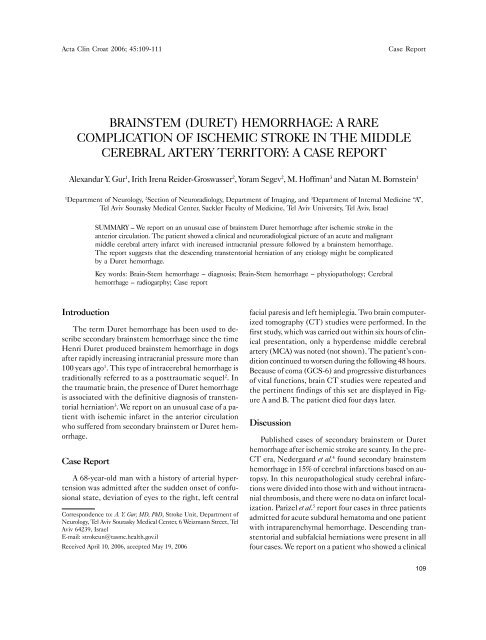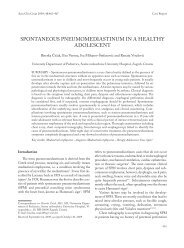07 Gur.p65
07 Gur.p65
07 Gur.p65
Create successful ePaper yourself
Turn your PDF publications into a flip-book with our unique Google optimized e-Paper software.
A. Acta Y. <strong>Gur</strong> Clin et al. Croat 2006; 45:109-111 Duret Case hemorrhage Report<br />
BRAINSTEM (DURET) HEMORRHAGE: A RARE<br />
COMPLICATION OF ISCHEMIC STROKE IN THE MIDDLE<br />
CEREBRAL ARTERY TERRITORY: A CASE REPORT<br />
Alexandar Y. <strong>Gur</strong> 1 , Irith Irena Reider-Groswasser 2 , Yoram Segev 2 , M. Hoffman 3 and Natan M. Bornstein 1<br />
1 Department of Neurology, 2 Section of Neuroradiology, Department of Imaging, and 3 Department of Internal Medicine “A”,<br />
Tel Aviv Sourasky Medical Center, Sackler Faculty of Medicine, Tel Aviv University, Tel Aviv, Israel<br />
Introduction<br />
SUMMARY – We report on an unusual case of brainstem Duret hemorrhage after ischemic stroke in the<br />
anterior circulation. The patient showed a clinical and neuroradiological picture of an acute and malignant<br />
middle cerebral artery infarct with increased intracranial pressure followed by a brainstem hemorrhage.<br />
The report suggests that the descending transtentorial herniation of any etiology might be complicated<br />
by a Duret hemorrhage.<br />
Key words: Brain-Stem hemorrhage – diagnosis; Brain-Stem hemorrhage – physiopathology; Cerebral<br />
hemorrhage – radiogarphy; Case report<br />
The term Duret hemorrhage has been used to describe<br />
secondary brainstem hemorrhage since the time<br />
Henri Duret produced brainstem hemorrhage in dogs<br />
after rapidly increasing intracranial pressure more than<br />
100 years ago 1 . This type of intracerebral hemorrhage is<br />
traditionally referred to as a posttraumatic sequel 2 . In<br />
the traumatic brain, the presence of Duret hemorrhage<br />
is associated with the definitive diagnosis of transtentorial<br />
herniation 3 . We report on an unusual case of a patient<br />
with ischemic infarct in the anterior circulation<br />
who suffered from secondary brainstem or Duret hemorrhage.<br />
Case Report<br />
A 68-year-old man with a history of arterial hypertension<br />
was admitted after the sudden onset of confusional<br />
state, deviation of eyes to the right, left central<br />
Correspondence to: A. Y. <strong>Gur</strong>, MD, PhD, Stroke Unit, Department of<br />
Neurology, Tel Aviv Sourasky Medical Center, 6 Weizmann Street, Tel<br />
Aviv 64239, Israel<br />
E-mail: strokeun@tasmc.health.gov.il<br />
Received April 10, 2006, accepted May 19, 2006<br />
facial paresis and left hemiplegia. Two brain computerized<br />
tomography (CT) studies were performed. In the<br />
first study, which was carried out within six hours of clinical<br />
presentation, only a hyperdense middle cerebral<br />
artery (MCA) was noted (not shown). The patient’s condition<br />
continued to worsen during the following 48 hours.<br />
Because of coma (GCS-6) and progressive disturbances<br />
of vital functions, brain CT studies were repeated and<br />
the pertinent findings of this set are displayed in Figure<br />
A and B. The patient died four days later.<br />
Discussion<br />
Published cases of secondary brainstem or Duret<br />
hemorrhage after ischemic stroke are scanty. In the pre-<br />
CT era, Nedergaard et al. 4 found secondary brainstem<br />
hemorrhage in 15% of cerebral infarctions based on autopsy.<br />
In this neuropathological study cerebral infarctions<br />
were divided into those with and without intracranial<br />
thrombosis, and there were no data on infarct localization.<br />
Parizel et al. 5 report four cases in three patients<br />
admitted for acute subdural hematoma and one patient<br />
with intraparenchymal hemorrhage. Descending transtentorial<br />
and subfalcial herniations were present in all<br />
four cases. We report on a patient who showed a clinical<br />
Acta Clin Croat, Vol. 45, No. 2, 2006 109
A. Y. <strong>Gur</strong> et al. Duret hemorrhage<br />
A B<br />
Fig. 1. (A) A large subacute infarction involving the cortical and subcortical right middle cerebral artery territory, including marked<br />
midline shift to the left and contralateral hydrocephaluseen. (B) A brainstem Duret hemorrhage (curved arrow), seen as the blood<br />
present in the fourth ventricle. The area was normal on the first study.<br />
and neuroradiological picture of an acute and large<br />
ischemic stroke in the anterior circulation. The stroke<br />
was followed by a brainstem hemorrhage as the result of<br />
a malignant MCA infarct with increased intracranial pressure<br />
that resulted in transtentorial herniation.<br />
Our case report suggests that there are multifactorial<br />
reasons for delayed secondary brainstem or Duret hemorrhage,<br />
and that descending transtentorial herniation<br />
of any etiology might be complicated by a Duret hemorrhage.<br />
Acknowledgment. We thank Esther Eshkol for editorial<br />
assistance.<br />
References<br />
1. ALEXANDER E Jr, KUSHNER J, SIX EG. Brainstem hemorrhages<br />
and increased intracranial pressure: from Duret to computed<br />
tomography. Surg Neurol 1982;17:1<strong>07</strong>-10.<br />
2. CAPLAN LR, ZERVAZ NT. Survival with permanent midbrain<br />
dysfunction after surgical treatment of traumatic subdural<br />
hematoma: the clinical picture of a Duret hemorrhage? Ann<br />
Neurol 1977;1:587-9.<br />
3. HOLLAND BA, BRANT-ZAWADZKI M, PITTS LH. The role<br />
of CT in the evaluation of trauma. Second edition. Baltimore:<br />
Williams & Wilkins, 1986:1-3.<br />
4. NEDERGAARD M, KLINKEN BM, PAULSON OB. Secondary<br />
brain stem hemorrhage in stroke. Stroke 1986;4:501-5.<br />
5. PARIZEL PM, MAKKAT S, JORENS PG et al. Brainstem<br />
hemorrhage in descending transtentorial herniation (Duret<br />
hemorrhage). Intensive Care Med 2002;28:85-8.<br />
110 Acta Clin Croat, Vol. 45, No. 2, 2006
A. Y. <strong>Gur</strong> et al. Duret hemorrhage<br />
Sažetak<br />
DURETOVO KRVARENJE: RIJETKA KOMPLIKACIJA ISHEMIJSKOG MOŽDANOG UDARA U PODRUÈJU<br />
SREDIŠNJE MOŽDANE ARTERIJE – PRIKAZ SLUÈAJA<br />
A. Y. <strong>Gur</strong>, I. I. Reider-Groswasser, Y. Segev, M. Hoffman i N. M. Bornstein<br />
Opisuje se rijedak sluèaj Duretova krvarenja moždanoga debla nakon ishemijskog moždanog udara u prednjem krvotoku.<br />
Bolesnik je pokazivao klinièku i neuroradiološku sliku akutnog i zloæudnog infarkta središnje moždane arterije uz povišen<br />
intrakranijski tlak, nakon èega je uslijedilo krvarenje u moždanom deblu. Ovaj prikaz ukazuje na to da se Duretovo krvarenje<br />
može pojaviti kao komplikacija kod silazne transtentorijske hernijacije bilo koje etiologije.<br />
Kljuène rijeèi: Krvarenje u moždanom deblu – klinièka slika; Krvarenje u moždanom deblu – fiziopatologija; Krvarenje u<br />
moždanom deblu – neurološka obrada<br />
Acta Clin Croat, Vol. 45, No. 2, 2006 111






